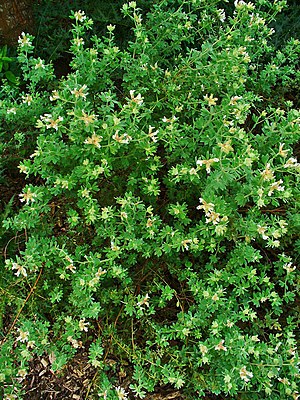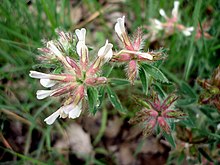Wire-haired cheekbones
| Wire-haired cheekbones | ||||||||||||
|---|---|---|---|---|---|---|---|---|---|---|---|---|

Wire-haired cheek clover ( Dorycnium hirsutum ) |
||||||||||||
| Systematics | ||||||||||||
|
||||||||||||
| Scientific name | ||||||||||||
| Dorycnium hirsutum | ||||||||||||
| ( L. ) Ser. |
The wire-haired cheek clover ( Dorycnium hirsutum ), also known as long-haired cheek clover or hairy cheek clover , is a species of the genus cheek clover ( Dorycnium ) in the subfamily of the butterflies (Faboideae) within the legume family (Fabaceae).
description
Vegetative characteristics
The wire-haired cheekbones grows as a richly branched and perennial herbaceous plant or as a semi- evergreen subshrub and reaches heights of 20 to 50 centimeters. The plant develops from a bud that overwinters above the ground. Because of its thick hair, the plant has a whitish-silvery appearance. Stems, leaves and calyx are provided with up to 2 millimeters long, protruding hairs ( trichomes ).
The alternately arranged leaves are sitting. The lowest pair of leaflets of the five-fold leaves appear like two stipules . The rachis is very short or absent. The mostly pointed or acuminate, short-stalked leaflets are ovate to obovate, more or less hairy and with entire margins. The two true stipules are minimal. However, the first pair of leaflets is interpreted by some authors as leaf-like stipules.
Generative characteristics
The flowering period extends from May to July. Few (five to ten) flowers are united in a dense, axillary and head-shaped inflorescence .
The hermaphrodite flowers are zygomorphic , up to 2 centimeters long and five-fold with a double flower envelope . The five white to pale pink petals are in the typical form of the Pea family together. In contrast to the herbaceous cheekbones , the tips of the wings of the long-haired cheekbones are not fused together. The long-haired, narrow, cup-shaped, partly reddish calyx has quite long and awl-shaped tips.
The bulbous, two-part and beaked , reddish, egg-shaped to ellipsoidal, almost bare legume is like the constant calyx 8 to 12 millimeters long and contains up to six seeds. The small, shiny and slightly speckled, smooth, orange-brown, slightly kidney-shaped to elliptical seeds are 1.5–2 millimeters in size.
The number of chromosomes is 2n = 14.
Occurrence
The wire-haired cheek clover is native to the Mediterranean (up to the Southern Alps), Portugal , and western Asia . It does best on dry, rocky slopes. It primarily thrives in the colline altitude range , but occurs up to the montane altitude range.
Taxonomy
The first publication was in 1753 under the name ( Basionym ) Lotus hirsutus by Carl von Linné in Species Plantarum , page 775. The new combination to Dorycnium hirsutum (L.) Ser. was founded in 1825 by Nicolas Charles Seringe in DC. : Prodr. 2, page 208. Another synonym of Dorycnium hirsutum (L.) Ser. is Bonjeanea hirsuta (L.) Rchb.
literature
- Manfred A. Fischer, Wolfgang Adler, Karl Oswald: Excursion flora for Austria, Liechtenstein and South Tyrol . 2nd, improved and enlarged edition. State of Upper Austria, Biology Center of the Upper Austrian State Museums, Linz 2005, ISBN 3-85474-140-5 .
- Pietro Zangheri: Flora d'Italia. CEDAM, Padova 1976.
- Thomas Gaskell Tutin , Vernon Hilton Heywood u. a .: Flora Europaea . Volume 2: Rosaceae to Umbelliferae. Cambridge University Press, 1968, ISBN 0-521-06662-X , p. 172, limited preview in Google Book Search.
- Marilena Idžojtić: Dendrology. Academic Press, 2018, ISBN 978-0-444-64175-5 , p. 240.
- Gustav Hegi : Illustrated flora of Central Europe . Volume IV, Part 3, Lehmanns, 1924, pp. 1376 ff.
Web links
- Dorycnium hirsutum (L.) Ser. In: Info Flora , the national data and information center for Swiss flora . Retrieved March 13, 2017.
- Thomas Meyer: Data sheet with identification key and photos at Flora-de: Flora von Deutschland (old name of the website: Flowers in Swabia ) .
Individual evidence
- ^ Dorycnium hirsutum at Tropicos.org. In: IPCN Chromosome Reports . Missouri Botanical Garden, St. Louis
- ↑ ILDIS World Database of Legumes 2010. Dorycnium hirsutum data sheet In: Euro + Med Plantbase - the information resource for Euro-Mediterranean plant diversity.


